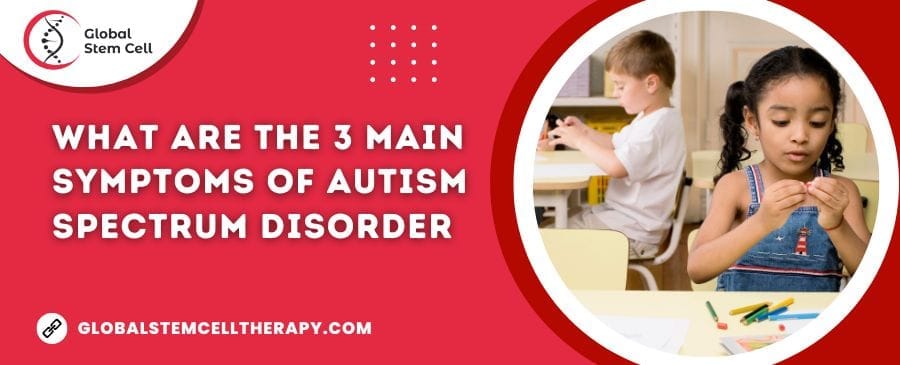Diving into the Autism Spectrum for a Closer Look at the 3 Essential Indicators
Table of Content
Autism Spectrum Disorder (ASD) is a complex neurodevelopmental disorder characterized by a wide range of symptoms and levels of impairment. ASD affects an individual’s social, behavioral, and communicative abilities, making it challenging for them to navigate everyday life. In this detailed article, we’ll explore the three main symptoms of autism spectrum disorder, providing insights and advice for families and caregivers on how to support individuals with ASD. Additionally, we’ll discuss various interventions and strategies that may be helpful in addressing these core symptoms Specially 3 Main Symptoms of Autism Spectrum Disorder
1. Social Communication and Interaction Difficulties
One of the most prominent symptoms of ASD is difficulty with social communication and interaction. People with autism often struggle to understand and interpret social cues, making it challenging for them to engage in reciprocal social interactions. This difficulty can manifest in various ways, including:
Nonverbal Communication
People with autism may have trouble understanding and using nonverbal communication, such as facial expressions, body language, and eye contact. They might avoid eye contact or appear indifferent to the emotions of others. This can make it difficult for them to connect with peers and form meaningful relationships.
Verbal Communication
Verbal communication can also be challenging for individuals with ASD. They may have a limited vocabulary, use repetitive speech patterns, or speak in a monotone voice. Some people with autism may be nonverbal and rely on alternative communication methods, such as sign language or communication devices.
2. Restricted and Repetitive Behaviors
Another hallmark of autism spectrum disorder is the presence of restricted and repetitive behaviors. These behaviors can take on many forms, ranging from repetitive body movements to fixations on specific objects or topics.
Repetitive Movements
Individuals with ASD may engage in repetitive movements, such as hand flapping, rocking, or spinning. These actions, known as “stimming,” can help people with autism self-regulate their emotions and sensory experiences. However, stimming can also be disruptive and draw unwanted attention in social situations.
Rituals and Routines
People with autism often rely on routines and rituals to navigate their daily lives. They may become distressed if their routines are disrupted or if they encounter unexpected changes. This rigidity can make it challenging for them to adapt to new situations and can create difficulties for families and caregivers.
3. Sensory Processing Issues
Many individuals with autism experience sensory processing issues, which can affect their ability to interpret and respond to sensory input from their environment. Sensory sensitivities can manifest in various ways, including:
Sensory Overload
People with ASD may become overwhelmed by sensory input, such as loud noises, bright lights, or strong smells. This sensory overload can result in anxiety, agitation, and meltdowns. To cope with sensory sensitivities, individuals with autism may seek out sensory-friendly environments or use tools such as noise-canceling headphones or weighted blankets.
Sensory Seeking
On the other hand, some individuals with autism may crave sensory stimulation and engage in sensory-seeking behaviors. They might enjoy activities that provide intense sensory input, such as swinging, bouncing, or spinning. Sensory seeking can also lead to self-injurious behaviors, such as head-banging or skin-picking, which require careful monitoring and intervention.
Early Signs of Autism in Young Children
Recognizing the early 3 Main Symptoms of Autism Spectrum Disorder of autism can be crucial in obtaining timely interventions and support. Parents and caregivers should be aware of the following early indicators of ASD in young children:
- Delayed language development: Children with ASD may have delayed speech and language skills, often not meeting typical developmental milestones.
- Lack of social responsiveness: Young children with autism may not respond to their name, show interest in playing with others, or engage in joint attention activities, such as pointing or showing objects to others.
- Limited eye contact: Infants and toddlers with ASD might struggle with maintaining eye contact, which is a critical component of social interaction and communication.
- Repetitive behaviors: Early signs of repetitive behaviors in young children may include hand flapping, rocking, or lining up toys in a specific order.
- Unusual sensory interests or aversions: Young children with ASD might display an unusual interest in certain textures, sounds, or tastes, or avoid specific sensory experiences altogether.
Diagnosing Autism Spectrum Disorder
Obtaining a diagnosis for autism spectrum disorder is a critical step in accessing appropriate support and intervention services. The diagnostic process typically involves:
Comprehensive Evaluation
A comprehensive evaluation, conducted by a multidisciplinary team of professionals, such as pediatricians, psychologists, and speech therapists, is essential for diagnosing ASD. The evaluation will assess a child’s cognitive, language, and social skills, as well as their behavioral patterns.
Diagnostic Criteria
The American Psychiatric Association’s Diagnostic and Statistical Manual of Mental Disorders (DSM-5) outlines specific criteria for diagnosing autism spectrum disorder. A diagnosis is based on the presence of persistent deficits in social communication and interaction, along with restricted, repetitive patterns of behavior, interests, or activities.
Intervention Strategies for Autism Spectrum Disorder
While there is no cure for autism spectrum disorder, various intervention strategies can help individuals with ASD develop essential skills, improve their quality of life, and increase their independence. Some of these interventions include:
Applied Behavior Analysis (ABA)
Applied Behavior Analysis (ABA) is a widely recognized intervention for autism spectrum disorder, focusing on improving specific behaviors, such as social skills, communication, and daily living skills. ABA uses positive reinforcement to encourage desired behaviors and reduce problematic ones.
Social Skills Training
Social skills training programs aim to teach individuals with ASD how to engage in appropriate social interactions, understand social cues, and build meaningful relationships. These programs may involve group therapy sessions, role-playing activities, and social stories.
Speech and Language Therapy
Speech and language therapy can help individuals with ASD develop their communication skills, such as expressive language, receptive language, and pragmatic language. Speech therapists work with clients to improve articulation, vocabulary, and conversation skills, and may also introduce alternative communication methods, such as sign language or communication devices, for nonverbal individuals.
Occupational Therapy
Occupational therapy can assist individuals with autism in developing the skills necessary for daily living and self-care. Occupational therapists work with clients to improve fine motor skills, sensory processing, and adaptive skills, such as dressing, grooming, and feeding.
Supporting Individuals with Autism Spectrum Disorder
Supporting individuals with ASD involves understanding their unique needs and implementing strategies to help them thrive. Some ways to support individuals with autism include:
Creating a Structured Environment
Individuals with ASD often benefit from structured environments that provide clear expectations, routines, and visual schedules. This structure can help them feel more secure and reduce anxiety related to unexpected changes.
Encouraging Social Interaction
Encouraging social interaction is essential for individuals with autism to develop their social skills and form meaningful relationships. Participating in group activities, playdates, or social skills training programs can help facilitate social interaction.
Providing Sensory Supports
Providing sensory supports can help individuals with ASD manage their sensory sensitivities and self-regulate their emotions. Sensory supports may include access to sensory-friendly environments, the use of noise-canceling headphones, or the introduction of calming tools, such as weighted blankets or fidget toys.
Autism Spectrum Disorder and Mental Health
Individuals with autism spectrum disorder are at a higher risk of experiencing mental health challenges due to the unique stressors and challenges they face. Anxiety, depression, and attention deficit hyperactivity disorder (ADHD) are common comorbidities seen in people with ASD. Addressing these mental health concerns is crucial for overall well-being and success.
Anxiety
Anxiety is prevalent among individuals with ASD, often stemming from social challenges, sensory sensitivities, or fear of change. Cognitive-behavioral therapy (CBT) and mindfulness-based interventions can be helpful in managing anxiety symptoms.
Depression
Depression can develop in individuals with autism due to feelings of isolation, social difficulties, or a sense of not fitting in. Early intervention, psychotherapy, and medication management can play a vital role in addressing depressive symptoms.
ADHD
ADHD often co-occurs with autism, and the presence of both conditions can exacerbate the challenges faced by individuals with ASD. Targeted interventions, such as behavior modification techniques and medication management, can help manage ADHD symptoms and improve overall functioning.
The Role of Family and Community Support
Family and community support plays a critical role in promoting the well-being and success of individuals with autism spectrum disorder. By fostering an inclusive and understanding environment, families and communities can help individuals with ASD reach their full potential.
Parent and Caregiver Education
Educating parents and caregivers about autism spectrum disorder, its symptoms, and intervention strategies can empower them to advocate for and support their loved ones with ASD. Participating in parent training programs, support groups, and workshops can provide valuable information and resources.
Inclusive Education
Inclusive education environments that provide necessary accommodations and supports can significantly impact the academic and social success of students with ASD. Collaborating with educators, special education professionals, and therapists can help create a supportive and inclusive educational experience.
Community Involvement
Fostering community involvement and understanding of autism spectrum disorder can help create inclusive spaces for individuals with ASD. Hosting community events, awareness campaigns, and training sessions can promote a greater understanding and appreciation of the unique strengths and challenges faced by individuals with autism.







